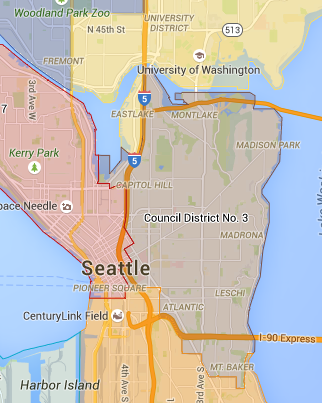
Article Note: The Urbanist is publishing a series of interviews with a selection of 2015 Seattle City Council candidates. In June, we will release our endorsements.
Pamela Banks is a political newcomer, running in central Seattle’s District 3. She hopes to unseat sitting Councilmember Kshama Sawant with her own progressive agenda. Banks is as local as they come with deep roots in central Seattle stretching back to her youth. Banks spent a thirty-year tenure in Seattle government working for multiple city agencies and completing her service as a community outreach director for the office of Mayor Greg Nickels. Banks now serves as President and CEO of the Urban League.
What would you do to make housing affordable to everyone in Seattle?
Banks opened the conversation by squarely declaring that “we have to do a variety of things and it’s not rent control.” Banks reasoned market rate housing and subsidized housing were both part of the housing solution. In her estimation, the City needs to reach out and work with developers to create new housing units. The City should also take a direct hand in property acquisition and development. Properties owned by the City should be redeveloped to provide housing options for residents. The City, Banks felt, could partner with successful housing providers like LIHI and Capitol Hill Housing to deliver successful projects and quality units to the market.
Banks pivoted to talk about the financials. She wants to pass a new housing levy to provide funding, but cautioned continued reliance on property taxes to fund city needs. Banks said that the current property taxes are often too much for many to bear now and that it’s time for the City to demand new revenue sources. She pointed to a new income tax and increased bonding capacity.
On the Linkage Fee and other impact fees, Banks said that she was nervous about them as revenue tools. Specifically, she said that concerned how collected fees might be distributed. She questioned whether the fees would go back to the neighborhoods from whence they came.

How does planning, transit policy, and development affect racial, social and economic inequalities in our city? What policies and efforts can we make to combat these inequalities?
Banks noted that zoning and transportation have been historically problematic for her area. She recounted two examples: I-90 planning process and the construction of light rail in the Rainier Valley as examples. Banks said that I-90 was originally planned to continue from I-5 to Mercer Island without an intermediate access junction near the Central District. Local residents fought hard for the Rainier Ave S ramps and ultimately won. She also shared how light rail in the Rainier Valley was a challenge to residents and businesses, with many simply closing up during construction. She praised the efforts to create the Rainier Community Development Fund, which helped retain many businesses on the corridor.
Banks argued that light rail isn’t serving the Rainier Valley well. She said that people live too far away from the stations and need better access. Banks praised light rail stations like Tukwila International Boulevard as examples for how station access should be provided. Specifically, Banks wants more park-and-ride structures to ensure that people can use light rail.
Banks voiced concern about rising gentrification trends in Seattle. She explained that the Central District has seen minority-majority populations plummet as the neighborhood sees new residents move in and locals move out. She feels that the Race and Social Justice Initiative needs improvement to drive greater balance on the issue.
Seattle’s Vision Zero plan aims to eliminate traffic deaths and serious injury by 2030. Do you think this target is achievable? Why or why not?
When asked if Vision Zero is achievable, Banks replied that there are “too many cars”. She went on to explain that she supports slowing speeds down in the city. She pointed to 23rd Ave and Rainier Ave S as examples of where and how the City should focus their efforts to reduce speed. But, she questioned if 2030 was really an achievable timeline to see Vision Zero become a full success. Echoing her declaration that there are “too many cars”, she said that Seattle has a long ways to go yet.
On transportation, Banks said that she wants to see Complete Street efforts better thought out. Focusing all modes on one street doesn’t deliver the best results in her estimation. Instead, modes need to be spread out amongst common streets in transportation corridors. Banks flexed her transportation muscles by saying that she supports transit, especially light rail.
How best should the city accommodate the next 20 years of growth?
Banks wasn’t coy on the question, but focused most of her time talking about transportation and parking. She said that density must be focused around transit, which would be a departure from the past. She explained that the City has done transportation planning backwards like light rail in the Rainier Valley that skirted around established, dense centers.
Banks said that the City is in need of a truly integrated transportation system, otherwise it risks people continuing their current patterns of driving first and foremost. Banks hopes to represent residents in Capitol Hill and said that many in the northern part of the neighborhood don’t support increased density because they lack appropriate services like access to light rail. Residents aren’t able to walk to the station from where they live.
Banks is concerned that parking is a problem for many fragile neighborhoods. She wants more comprehensive parking assessments to ensure that there is adequate parking in places like Pioneer Square.
When asked what she thought about parking minimums in new development, Banks said that it was a must. She added that the only exceptions should be around certain light rail stations like Beacon Hill. Although, others like Mount Baker (McClellan) might not be appropriate for parking-free regulations. Pointing to immigrant, refugee, and elderly communities, Banks said that these groups have a strong need for vehicle access due to their familial formations.
What is the most important transportation project in your district?
Banks singled out the Capitol Hill light rail station as the biggest project slated for District 3. She explained that the project will deliver more than just transit, but also a series of large housing developments with ample affordable housing mixed in. She also highlighted three other projects as key for the district: Rainier Ave, the 520 trail, and 23rd Ave. Bank said that the 23rd Avenue Corridor Project (stretching from Southeast Seattle to Montlake) would be a game changer due to its multi-modal approach to Complete Streets. She felt that many locals will appreciate the new Neighborhood Greenway paralleling 23rd Ave.
Read our interviews with other District 3 candidates Morgan Beach and Rod Hearne.
Stephen is a professional urban planner in Puget Sound with a passion for sustainable, livable, and diverse cities. He is especially interested in how policies, regulations, and programs can promote positive outcomes for communities. With stints in great cities like Bellingham and Cork, Stephen currently lives in Seattle. He primarily covers land use and transportation issues and has been with The Urbanist since 2014.


